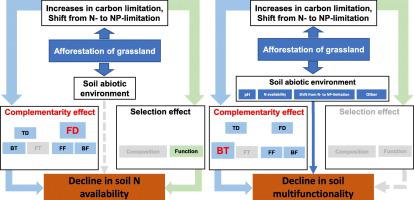Science of the Total Environment ( IF 9.8 ) Pub Date : 2020-11-21 , DOI: 10.1016/j.scitotenv.2020.143663 Leilei Ding , Puchang Wang

|
Microbes simultaneously drive multiple functions (multifunctionality) that support human well-being. However, the structure and function of microbial communities and their impact on soil multifunctionality following grassland afforestation remains unknown, thus hindering our ability to formulate conservation policies. We compared soil bacterial and fungal communities, soil abiotic properties, and soil nitrogen (N) function and multifunctionality in the afforested sites that were previously grassland, on a subtropical plateau in China. We also explored the degree to which the niche complementarity effect (diversity) and the selection effect (taxonomic and functional composition) of microbes are linked to soil N function and multifunctionality. We found that afforestation of grassland significantly decreased pH, available N concentration and density, and soil multifunctionality. However, afforestation significantly increased C (carbon) limitation and shifted soil microbes from being limited by N to, instead, being co-limited by N and P (phosphorus). The significant decrease in available N was primarily driven by soil microbes. In shaping soil N availability, the effect of bacterial diversities was stronger than that of fungal diversities, and the effect of fungal functional diversities was stronger than that of bacterial functional diversities. The effect of functional diversities was greater than that of all the significant changes in the functions and, also, the significant changes in the N-related functions. These results further emphasized that functional niche complementarity dominated soil N availability. In addition, bacterial taxonomic diversities showed positive effects of niche complementarity on soil multifunctionality; Ultimately, the losses in bacterial taxonomic diversities derived from the increases in C limitation and the shifts in NP limitation combined to impaired soil multifunctionality. Our results suggested that the optimization of soil microbial functional diversities might increase soil N availability, and that minimizing losses of soil microbial taxonomic diversities by optimizing soil abiotic environments might improve soil multifunctionality.



























 京公网安备 11010802027423号
京公网安备 11010802027423号